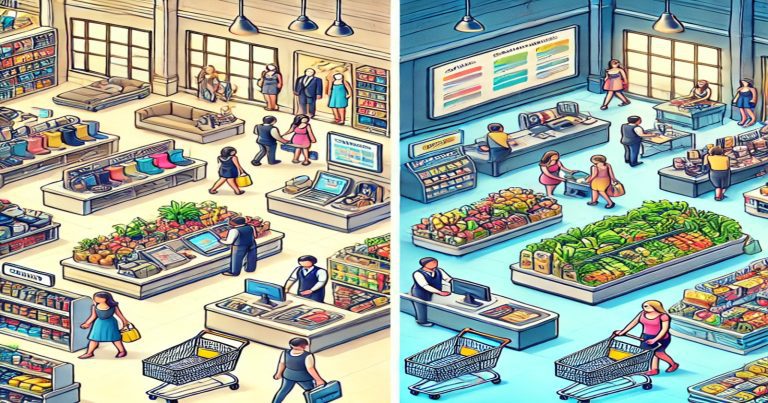The difference between a departmental store and a supermarket is based on purpose, layout, range of products, and customer service. A departmental store is a big retail house that offers an assortment of merchandise commodities, such as clothing, furniture, cosmetics, electronics, and groceries, under one roof. On the other hand, a supermarket is a self-service retail house that mainly sells food, beverages, and household essentials at competitive prices. Both play an important role in modern retail but cater to different customer needs. This article will examine the definitions, their key differences, and how they influence the retail industry.
What is Departmental Store?
A departmental store is a large-scale retail outlet providing various products in various sections or departments. The different departments of a departmental store specialize in specific product categories, such as clothing, cosmetics, home appliances, groceries, and electronics. The main goal of a departmental store is to give the customer a one-stop shopping experience. Popular examples in India are Shoppers Stop, Big Bazaar, and Lifestyle.
Departmental stores bring all the needed products under a single roof, including clothing and footwear, electrical goods, and grocery items, thus making shopping extremely easy. Daily necessities and luxury articles are available there. From selling tickets to wrapping, staff will be eager to help clients with their inquiries. Nearly all shops have better infrastructure like cooling, elevators, and parking. Almost all of these shops have set prices, with seasonal discounts possible.
Some of the popular departmental stores in India are Shoppers Stop, offering branded clothing and accessories; Lifestyle, which has fashion, footwear, and home décor; and Big Bazaar, which deals with groceries, clothing, and household essentials, and Pantaloons, trendy fashion.
What is a Supermarket?
A supermarket is a retailing shop with vast self-service floor space that mostly sells groceries and food products. Supermarkets, in their general design, emphasize fast, tangle-free shopping, where buyers pick their choices directly from the shelves at check-out counters. Retail shops should sell everyday needs at competitive prices, and because of this nature, they usually make their gains from large sale volumes.
Supermarkets allow customers to shop independently based on a self-service model. Their main business products include food, groceries, fresh produce, dairy, and packaged goods. Such stores make meager profit margins but accumulate them through mass sales. Goods are placed in aisles and, therefore, easy to find. Scanner bars and computerized billing are fast ways to pay for purchased goods. Customers seek frequent offers since they wish to save.
D-Mart is another popular supermarket selling affordable groceries and other household items. Reliance Fresh sells fresh fruits and vegetables in particular. More Supermarket sells daily necessities at easy-on-the-pocket prices, whereas Spencer’s sells food items of super quality with a premium feel. Big Bazaar has the supermarket segment, where grocery shopping is focused on keeping a constant supply of essentials for consumers.
Difference Between Departmental Store and Supermarket
A Difference between a department store and a supermarket would be in business models and how people shop from these stores. Though they deal with consumers, the variety, arrangement, price plan, and customer service also differ.
Product Range
Such commodities as clothing, cosmetics, electronics, and groceries are sold in departmental stores. The services make shopping easy because everything available can be found in a single store. The varieties range from high-end items to essentials.
The supermarket mainly caters to groceries, packaged food products, and home essentials. The supermarkets ensure the availability of fresh and daily-use commodities at a competitive price. Regular grocery shopping and fresh fruits and vegetables attract customers to come back to the supermarket.
Shopping Experience
Departmental stores are available with sales staff to facilitate customer service. The employees serve the customers regarding their purchases and queries about specific products and services like gift-wrapping facilities. This personalized shopping experience creates a more amenable environment that allows customers to find their desired products easily.
Supermarkets use a self-service shopping model with minimal contact with people, and customers come and pick products. The clients use carts or baskets for easier shopping. Shoppers move faster through the store with an efficient process and check out immediately.
Store Layout
A departmental store has several sections. All the sections focus on different items, such as clothing, electronic appliances, and cosmetics. All these sections of the store make it easy for customers to wander through them and choose what they want.
Supermarkets are designed in an aisle-based format for easy selection of products. Items are systematically arranged on shelves, which makes it easier for shoppers or even consumers to find products.
Pricing Strategy
Sometimes, they supplement the fixed pricing strategy of departmental stores with discounts offered on specific goods. Their quality-oriented pricing strategy sells branded products at competitive prices. They present discounts or special offers at times of sales seasons.
Supermarkets sell at competitive pricing, and every so often, they offer fantastic offers and discount deals for bulk purchases. They attract budget-conscious shoppers by providing lower prices on groceries and daily essentials.
Customer Focus
Departmental stores target those customers who seek a premium shopping experience. The quality of the products, modern infrastructure, and excellent customer service are highlighted in these stores. These stores attract shoppers who want a comfortable and well-organized retail environment.
Supermarkets target budget-conscious customers who are sensitive to high prices. Its objective is to sell high-quality products at the lowest possible price. Supermarkets thus ensure immediate service and are giving discounts to get more cost-sensitive customers.
| Basis | Departmental Store | Supermarket |
| Product Range | Sells various goods, including clothing, cosmetics, electronics, and groceries. | Mainly focuses on groceries, packaged foods, and household essentials. |
| Shopping Experience | Offers customer service with assistance from sales staff. | Self-service shopping with minimal staff interaction. |
| Store Layout | Divided into multiple sections or departments. | Aisle-based layout for easy product selection. |
| Pricing Strategy | Fixed pricing, occasional discounts on specific products. | Competitive pricing with frequent offers and bulk discounts. |
| Customer Focus | Targets customers looking for a premium shopping experience. | Focuses on budget-conscious shoppers seeking everyday essentials. |
Departmental Store vs Supermarket FAQs
1. What is the difference between a departmental store and a supermarket?
The department store sells various products in different sections. The supermarket primarily sells groceries and household necessities.
2. Which one is better, departmental store or a supermarket?
It is dependent upon customer needs. The departmental store is more effective for having many things, whereas a supermarket is great for grocery shopping at cheap prices.
3. Is a departmental store a grocer like supermarket?
Yes, some department stores have sections for grocery sales, but a department store sells clothes, electronics, and other items, whereas a supermarket sells mainly edible and household goods.
4. Why are big supermarkets cheaper compared to departmental stores?
Due to high sales volumes but low-profit percentages, supermarkets easily sell competitive products with offers and discounts made frequently.
5. Is Big Bazaar different from Dmart?
No, Big Bazaar is a multi-product departmental store, and D-Mart is a supermarket, providing grocery and household range at lower prices.


